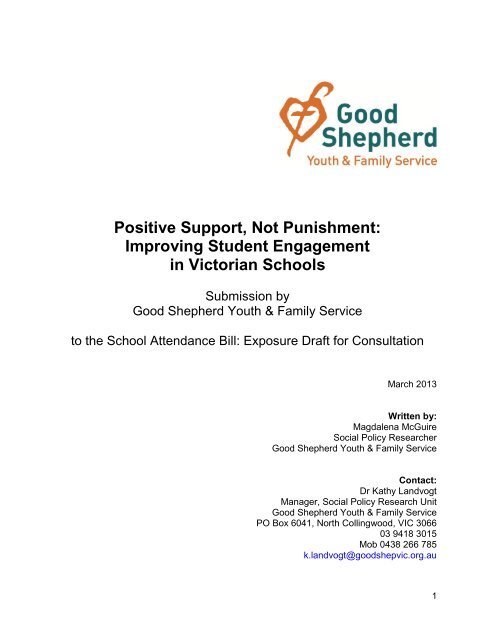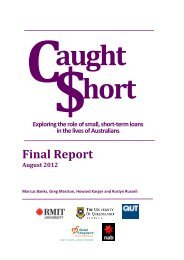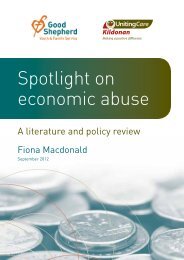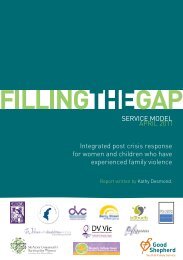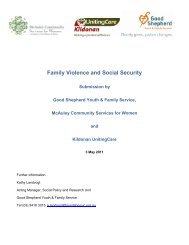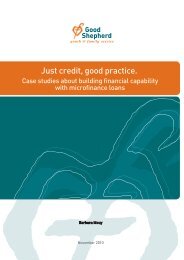Submission to School Attendance Bill March 2013 - Good Shepherd ...
Submission to School Attendance Bill March 2013 - Good Shepherd ...
Submission to School Attendance Bill March 2013 - Good Shepherd ...
Create successful ePaper yourself
Turn your PDF publications into a flip-book with our unique Google optimized e-Paper software.
Positive Support, Not Punishment:<br />
Improving Student Engagement<br />
in Vic<strong>to</strong>rian <strong>School</strong>s<br />
<strong>Submission</strong> by<br />
<strong>Good</strong> <strong>Shepherd</strong> Youth & Family Service<br />
<strong>to</strong> the <strong>School</strong> <strong>Attendance</strong> <strong>Bill</strong>: Exposure Draft for Consultation<br />
<strong>March</strong> <strong>2013</strong><br />
Written by:<br />
Magdalena McGuire<br />
Social Policy Researcher<br />
<strong>Good</strong> <strong>Shepherd</strong> Youth & Family Service<br />
Contact:<br />
Dr Kathy Landvogt<br />
Manager, Social Policy Research Unit<br />
<strong>Good</strong> <strong>Shepherd</strong> Youth & Family Service<br />
PO Box 6041, North Collingwood, VIC 3066<br />
03 9418 3015<br />
Mob 0438 266 785<br />
k.landvogt@goodshepvic.org.au<br />
1
Recommendations<br />
<strong>Good</strong> <strong>Shepherd</strong> Youth & Family Service advises that:<br />
1. The Vic<strong>to</strong>rian Government collects and annually publishes disaggregated data about the<br />
school attendance and retention rates of children and young people in Vic<strong>to</strong>ria, including<br />
those who are from low socioeconomic backgrounds, who are Indigenous, who are from<br />
culturally and linguistically diverse backgrounds, who live in out of home care, and who<br />
have disabilities.<br />
2. The Vic<strong>to</strong>rian Government does not introduce the penalty infringement process outlined<br />
in the Education and Training Reform Amendment (<strong>School</strong> <strong>Attendance</strong>) <strong>Bill</strong> 2006.<br />
3. The Vic<strong>to</strong>rian Government builds on the range of positive strategies for addressing<br />
student engagement and retention that have already been developed by the Department of<br />
Education and Early Childhood Development, such as those outlined in Effective <strong>School</strong>s<br />
are Engaging <strong>School</strong>s: Student Engagement Policy Guidelines.<br />
4. The Vic<strong>to</strong>rian Government implements the recommendations for schools outlined in the<br />
report by <strong>Good</strong> <strong>Shepherd</strong> Youth & Family Service, Jesuit Social Services and MacKillop<br />
Family Services titled I Just Want <strong>to</strong> Go <strong>to</strong> <strong>School</strong>: S<strong>to</strong>ries of Young People Experiencing<br />
Educational Disadvantage.<br />
2
About <strong>Good</strong> <strong>Shepherd</strong> Youth & Family Service<br />
<strong>Good</strong> <strong>Shepherd</strong> Youth & Family Service works <strong>to</strong> promote the human rights and dignity of<br />
people who are marginalised in the community. Our organisation assists, empowers and<br />
advocates on behalf of those people who are at the very fringes of society. Each year we<br />
directly support over 12,000 young people, women and families in Vic<strong>to</strong>ria. We have also<br />
provided innovation and leadership in the microfinance movement throughout Australia for<br />
over three decades.<br />
Central <strong>to</strong> our work is the strong belief that everyone deserves a stake in their community<br />
and the conditions of life that make participation in community possible. This includes<br />
access <strong>to</strong> high quality education and training programs, and decent employment.<br />
The communities in and around Melbourne in which <strong>Good</strong> <strong>Shepherd</strong> Youth & Family<br />
Service operates experience financial disadvantage, and our programs directly address this<br />
and many of the accompanying challenges. These programs include financial counselling,<br />
microfinance, family support, youth emergency housing, family violence support<br />
services and refuge accommodation, and community education.<br />
Our inheritance of the mission and vision of the <strong>Good</strong> <strong>Shepherd</strong> Sisters directly informs our<br />
advocacy and direct service work, especially where it impacts on the lives of disadvantaged<br />
young people, women and girls.<br />
Our organisation has a keen interest in the area of education. We have conducted research<br />
and systemic advocacy around the issues of student engagement with the education<br />
system and the rising costs of education.<br />
<strong>Good</strong> <strong>Shepherd</strong> Youth & Family Service is linked in with a broader network of organisations,<br />
including <strong>Good</strong> <strong>Shepherd</strong> in the United States. Since 1996, <strong>Good</strong> <strong>Shepherd</strong> has had a<br />
consultative status at the United Nations Economic and Social Council. This affiliation has<br />
enabled <strong>Good</strong> <strong>Shepherd</strong> <strong>to</strong> further its mission <strong>to</strong> promote the human rights of vulnerable<br />
groups of people, and <strong>to</strong> challenge the conditions that condemn people <strong>to</strong> a marginalised<br />
life.<br />
This practice experience, research and human rights background give us an understanding<br />
of the issues surrounding the engagement of young people and their parents in the<br />
education system. It is from this evidence-base that we draw in making this submission.<br />
3
Introduction<br />
<strong>Good</strong> <strong>Shepherd</strong> Youth & Family Service welcomes the opportunity <strong>to</strong> comment on the<br />
Exposure Draft of the <strong>School</strong> <strong>Attendance</strong> <strong>Bill</strong> (the <strong>Bill</strong>). The <strong>Bill</strong> seeks <strong>to</strong> impose fines on<br />
parents of children and young people who do not attend school for five days in one year,<br />
and do not have a “reasonable excuse” for their absenteeism. 1 The <strong>Bill</strong> also proposes <strong>to</strong><br />
fine parents of children who are of a compulsory school age, and who are not enrolled in a<br />
school or in home schooling.<br />
We recognise the importance of children and young people participating in the education<br />
system. Education is consistently identified as the most important pathway out of poverty<br />
and disadvantage. 2 Poor attendance at school can adversely impact on a young person‟s<br />
educational achievements and life chances. 3 Therefore, absenteeism and non-enrolment<br />
are problems that need <strong>to</strong> be identified and addressed at an early stage. However, this<br />
raises the question: how should these problems best be approached? While there are no<br />
easy solutions in this area, the evidence indicates that we need <strong>to</strong> implement positive<br />
strategies <strong>to</strong> support students and parents in engaging with school life. 4 There is certainly<br />
no evidence that punitive mechanisms – such as imposing fines – are effective strategies<br />
for addressing these issues. In fact, these punitive measures are likely <strong>to</strong> have a<br />
detrimental effect on student attendance and parental participation in the education system.<br />
We believe that, if introduced, the penalty system outlined in the <strong>Bill</strong> could entrench the<br />
disengagement of disadvantaged young people and their parents from the education<br />
system. In light of these concerns, we question whether the <strong>Bill</strong> is compatible with the<br />
Charter of Human Rights and Responsibilities Act 2006. 5<br />
It should be noted that jurisdictions that have introduced these types of punitive measures,<br />
such as the United Kingdom, have found that they seem <strong>to</strong> have little impact on increasing<br />
student retention in the long-term. 6 Furthermore, it has anecdotally been reported that<br />
these punitive measures have resulted in a host of unintended consequences. For<br />
example, we have had reports that the enforcement of these punitive measures has placed<br />
1 The term „parents‟ is used in this submission <strong>to</strong> refer <strong>to</strong> both parents and guardians.<br />
2 Campbell, Lea; McGuire, Magdalena; and S<strong>to</strong>ckley, Che I Just Want <strong>to</strong> Go <strong>to</strong> <strong>School</strong>: Voices of Young<br />
People Experiencing Educational Disadvantage (<strong>Good</strong> <strong>Shepherd</strong> Youth & Family Service, Jesuit Social<br />
Services and MacKillop Family Services, 2012) at p.15. Report available at<br />
http://www.goodshepvic.org.au/current_projects#Section1.<br />
3 Withers, Graeme „Disenchantment, Disengagement, Disappearance: Some Recent Statistics and a<br />
Commentary on Non-<strong>Attendance</strong> at <strong>School</strong>‟, A paper prepared for the Learning Choice Expo Conducted<br />
by the Dusseldorp Skills Forum, Sydney 23-24 June 2004, at p.5.<br />
4 See, for example: Campbell, Lea et al, I Just Want <strong>to</strong> Go <strong>to</strong> <strong>School</strong> (2012); National Educational Welfare<br />
Board, „<strong>School</strong> <strong>Attendance</strong> and Participation: What Works and Why? Report from the National Education<br />
Welfare Board Conference‟ (2008); Emerson, Lance; Fear, Josh; Fox, Stacey; Sanders, Emma; Parental<br />
Engagement in Learning and <strong>School</strong>ing: Lessons from Research (Family-<strong>School</strong> & Community<br />
Partnerships Bureau 2012); and Kendall, Sally; Straw, Suzanne; Jones, Megan; Springate, Iain; and<br />
Grayson, Hilary Narrowing the Gap in Outcomes for Vulnerable Groups: A Review of the Research<br />
Evidence (National Foundation for Educational Research, 2008); Department of Education, Employment<br />
and Training Vic<strong>to</strong>ria Keeping Kids at <strong>School</strong>: Issues in <strong>School</strong> <strong>Attendance</strong> (1999).<br />
5 See, in particular, section 17 which protects families and children.<br />
6 Sheldon, Nicola „Tackling Truancy: What Works?‟, His<strong>to</strong>ry and Policy: Connecting His<strong>to</strong>rians, Policy<br />
Makers and the Media‟ (undated) available at http://www.his<strong>to</strong>ryandpolicy.org/papers/policy-paper-<br />
84.html.<br />
4
additional stress on families that were already socially and economically disadvantaged. In<br />
turn, these measures appeared <strong>to</strong> contribute <strong>to</strong> further difficulties experienced by such<br />
families, including the breakdown of relationships or young people leaving home at an early<br />
age. 7 The United Kingdom experience indicates that, while absenteeism and nonenrolment<br />
need <strong>to</strong> be identified and addressed at an early stage, they should not be dealt<br />
with in a punitive manner.<br />
There is also a lack of evidence surrounding the impetus for the <strong>Bill</strong>. The Exposure Draft is<br />
not accompanied by any information about what lies behind the perceived need for the<br />
legislative changes. Therefore, some key questions surrounding the <strong>Bill</strong> are left<br />
unanswered. These include questions such as: Are the rates of student absenteeism and<br />
non-enrolment actually increasing in Vic<strong>to</strong>ria? If so, which groups of individuals are<br />
associated with this this increase? And what are the underlying reasons for this increase?<br />
As this data is not readily available, the extent of this problem in Vic<strong>to</strong>ria remains unclear. 8<br />
In the absence of transparent, publicly available information in this area, it is difficult <strong>to</strong><br />
devise a targeted response <strong>to</strong> the problems of absenteeism and non-enrolment. Therefore,<br />
the first step <strong>to</strong> addressing these issues is <strong>to</strong> produce comprehensive, transparent<br />
information about school attendance and retention rates throughout Vic<strong>to</strong>ria. It is important<br />
that this data is disaggregated in order <strong>to</strong> assess the attendance rates of groups of children<br />
and young people who are at risk of disengaging from the education system. Having said<br />
this, it should be pointed out that, even if the rates of absenteeism and non-enrolment are<br />
increasing in Vic<strong>to</strong>ria (and there is no evidence that this is the case) we do not believe that<br />
imposing fines will alleviate these problems. A better strategy is <strong>to</strong> introduce positive<br />
mechanisms for supporting parents and their children <strong>to</strong> participate in the education system.<br />
Recommendation<br />
1. The Vic<strong>to</strong>rian Government collects and annually publishes disaggregated data about the<br />
school attendance and retention rates of children and young people in Vic<strong>to</strong>ria, including<br />
those who are from low socioeconomic backgrounds, who are Indigenous, who are from<br />
culturally and linguistically diverse backgrounds, who live in out of home care, and who<br />
have disabilities.<br />
The rest of this submission addresses the questions that accompany the Exposure Draft of<br />
the <strong>School</strong> <strong>Attendance</strong> <strong>Bill</strong>.<br />
7 These reports were made by a <strong>Good</strong> <strong>Shepherd</strong> Youth & Family Service youth worker who worked in the<br />
United Kingdom in the area of education, and who had direct experience in moni<strong>to</strong>ring the enforcement of<br />
punitive measures aimed at increasing student attendance and retention at school.<br />
8 The Vic<strong>to</strong>rian Child and Adolescent Moni<strong>to</strong>ring System (also known as „VCAMS‟) collects information<br />
about the average rates of student attendance at primary and secondary school. However, this data is<br />
not readily available <strong>to</strong> the public, nor is it disaggregated. There are also various research reports that<br />
outline the school attendance rates for particular groups of individuals, such as children and young people<br />
living in out of home care in Vic<strong>to</strong>ria. See, for example, Wise, Sarah; Pollock, Sarah; Mitchell, Gaye;<br />
Argus, Cathy & Farquhar, Peta, Care-System Impacts on Academic Outcomes (Anglicare Vic<strong>to</strong>ria and<br />
Wesley Mission Vic<strong>to</strong>ria, 2010). However, in Vic<strong>to</strong>ria there is a lack of state-wide data that compares the<br />
rates of school attendance for different groups of individuals the state.<br />
5
Do you support the proposed legislative change?<br />
We understand that the Education Training and Reform Act 2006 already outlines penalties<br />
for parents who do not ensure that their child attends or is enrolled in school without a<br />
reasonable excuse and that, currently, it is necessary <strong>to</strong> attend court <strong>to</strong> enforce these<br />
penalties. We note that the proposed legislative changes are seeking <strong>to</strong> enable “more<br />
effective enforcement” of these penalties. 9 In essence, the proposed changes are seeking<br />
<strong>to</strong> expedite the process for the imposition of fines on parents whose children are absent<br />
from or not enrolled in school without a reasonable excuse.<br />
<strong>Good</strong> <strong>Shepherd</strong> Youth & Family Service does not support the proposed legislative changes.<br />
We believe that the proposed changes are driven by assumptions of questionable validity.<br />
Implicitly, they define the problems of absenteeism and non-enrolment as ones of parental<br />
or student negligence. In fact, the available research negates these assumptions. The<br />
research indicates that many young people who have poor school attendance records are<br />
not merely rebellious or „difficult‟, but face genuine hurdles in participating in the education<br />
system. 10 For these young people, being absent from school is “not a lifestyle choice, but<br />
rather a response <strong>to</strong> profound and complex challenges they face in their lives”. 11<br />
In light of this, we propose that the problems of absenteeism (whether this be truancy or<br />
„parental condoned absenteeism‟) 12 and non-enrolment need <strong>to</strong> be framed more broadly as<br />
problems of educational disadvantage and disengagement. The evidence indicates that the<br />
key groups of young people who are likely <strong>to</strong> experience educational disadvantage and<br />
disengagement are those who:<br />
are affected by poverty<br />
are Indigenous<br />
are from culturally and linguistically diverse (CALD) backgrounds, including refugees<br />
live in out-of-home care<br />
have parents who are involved in the criminal justice system<br />
experience disabilities or mental health issues, or whose parents experience these<br />
issues<br />
have experienced, or whose parents have experienced, domestic and family<br />
violence<br />
are pregnant or parenting. 13<br />
9 Department of Education and Early Childhood Development „<strong>School</strong> <strong>Attendance</strong> <strong>Bill</strong>: Exposure Draft for<br />
Consultation‟ (<strong>2013</strong>).<br />
10 Campbell, Lea et al I Just Want <strong>to</strong> Go <strong>to</strong> <strong>School</strong> (2012); Randall, Linda; Morstyn, Lisa and Walsh, Kate<br />
Two Way Street: Young People Informing Improvements <strong>to</strong> <strong>School</strong>s and Youth Services (Youth Affairs<br />
Council of Vic<strong>to</strong>ria, 2012).<br />
11 Randall, Linda et al Two Way Street (2012) at p.2.<br />
12 On this point, it should be noted that the distinction between „truancy‟ and „parental condoned<br />
absenteeism‟ is not as clear cut as the Exposure Draft implies. For example, some parents may be<br />
aware that their child is truant from school, but lack the capacity <strong>to</strong> s<strong>to</strong>p this from happening.<br />
13 Campbell, Lea et al, I Just Want <strong>to</strong> Go <strong>to</strong> <strong>School</strong> (2012); Wise, Sarah et al Care-System Impacts on<br />
Academic Outcomes (2010); Shacklock, Geoff „Parenting Students in Secondary <strong>School</strong> Settings: The<br />
Challenge of the „Dilemma of Difference‟‟ (undated) available at<br />
6
The particular issues faced by some of these groups of young people are highlighted below.<br />
Case Study: Domestic Violence and Intergenerational Trauma<br />
„Darlene‟ is a woman who in her 40s. She has a 10 year old child who attends primary<br />
school named „Sarah‟. Darlene separated from her partner, Sarah‟s father, two years ago.<br />
Darlene‟s former partner was extremely violent <strong>to</strong>wards her and also sometimes <strong>to</strong>wards<br />
Sarah. Darlene is deeply traumatised as a result of the domestic violence and she has<br />
developed mental health issues. Sarah is also traumatised by her experiences and is<br />
finding it difficult <strong>to</strong> cope with her mother‟s mental health issues.<br />
When Darlene is feeling really bad, she keeps Sarah home from school so her child can<br />
keep her company and look after her. She gets Sarah <strong>to</strong> make her cups of tea and give her<br />
massages.<br />
There is no doubt that Sarah should be at school rather than staying at home <strong>to</strong> look after<br />
her mother. However, imposing fines on a traumatised family is not the solution <strong>to</strong> this<br />
problem. Rather, the family needs support <strong>to</strong> help them address the trauma they have<br />
experienced.<br />
Poverty<br />
<strong>Good</strong> <strong>Shepherd</strong> Youth & Family Service recently completed a research project on<br />
educational disadvantage in collaboration with Jesuit Social Services and MacKillop Family<br />
Services. The report is called I Just Want <strong>to</strong> Go <strong>to</strong> <strong>School</strong>: S<strong>to</strong>ries of Young People<br />
Experiencing Educational Disadvantage. 14 The report found that one of the key reasons for<br />
educational disengagement is poverty. <strong>School</strong> is one of the chief settings in which young<br />
people become aware of – and keenly feel the effects of – poverty. 15 The young people<br />
who <strong>to</strong>ok part in our research project reported that their sense of being “different” at school<br />
led <strong>to</strong> difficulties such as being ostracised, bullied and experiencing violence. Many of<br />
these young people indicated that, while they wanted <strong>to</strong> get an education, they were often<br />
reluctant <strong>to</strong> go <strong>to</strong> school due <strong>to</strong> the fact that this was not a safe or welcoming environment<br />
for them. In response <strong>to</strong> these issues, the report recommended that schools should be<br />
supported <strong>to</strong> provide strong prevention and early intervention responses <strong>to</strong> student<br />
wellbeing issues, including bullying and mental health issues. The report also<br />
recommended that schools should conduct “equity audits” <strong>to</strong> promote equal access <strong>to</strong><br />
learning experiences for all students – including those from lower socioeconomic<br />
backgrounds. 16<br />
http://www.tasa.org.au/conferences/conferencepapers07/papers/106.pdf; Randall, Linda et al Two Way<br />
Street (2012).<br />
14 Campbell, Lea et al, I Just Want <strong>to</strong> Go <strong>to</strong> <strong>School</strong> (2012).<br />
15 Campbell, Lea et al, I Just Want <strong>to</strong> Go <strong>to</strong> <strong>School</strong> (2012) at p.15.<br />
16 Campbell, Lea et al, I Just Want <strong>to</strong> Go <strong>to</strong> <strong>School</strong> (2012) at p.6.<br />
7
Our practice experience also indicates that children and young people from disadvantaged<br />
backgrounds may stay at home from school if they do not have enough money for food <strong>to</strong><br />
take <strong>to</strong> school, or for transport <strong>to</strong> and from school, for example. 17 It is also important <strong>to</strong> be<br />
aware that it is not unusual for children and young people from economically disadvantaged<br />
backgrounds <strong>to</strong> support their parents <strong>to</strong> undertake paid work, or <strong>to</strong> undertake paid work<br />
themselves in order <strong>to</strong> contribute <strong>to</strong> the household income. 18 Some children and young<br />
people may also have <strong>to</strong> act as carers for siblings or their parents (for example, if their<br />
parent is experiencing physical or mental health issues). 19 These family responsibilities can<br />
adversely impact on the ability of children and young people <strong>to</strong> attend school. Therefore,<br />
addressing these financial and other barriers is a key step <strong>to</strong> enabling these children and<br />
young people <strong>to</strong> attend school.<br />
Case Study: No Shoes for <strong>School</strong><br />
„Marie‟ is a single mother with two children who are of primary school age, „Sean‟ and<br />
„Jake‟. 20 Marie is committed <strong>to</strong> ensuring that her children receive an education, but she<br />
struggles <strong>to</strong> meet the costs of their schooling. Marie reports that her sons‟ public schools<br />
are strict about them wearing school uniforms. However, their uniforms are expensive, and<br />
pose an additional cost that she does not need.<br />
On one occasion, Marie‟s son Sean came home from the pool after having lost a shoe. He<br />
had been wearing his only pair of shoes, so he didn‟t have any others he could wear as a<br />
backup. Marie said that she didn‟t want <strong>to</strong> send her son <strong>to</strong> school without shoes as she was<br />
worried about him being reprimanded by the school and ostracised by his peers. Sean<br />
therefore stayed home from school for a few days until Marie got paid. When Marie was<br />
paid, she bought him a pair of shoes and he was able <strong>to</strong> return <strong>to</strong> school.<br />
Marie often worries about the costs of the children‟s schooling and their extra-curricular<br />
activities. She says that “the kids really want <strong>to</strong> go <strong>to</strong> things like school camps and it‟s hard<br />
<strong>to</strong> say no”. She occasionally accesses emergency relief <strong>to</strong> assist with the costs of her sons‟<br />
education.<br />
Marie‟s case illustrates that financial difficulties can be an obstacle <strong>to</strong> children attending<br />
school. These difficulties would no doubt be exacerbated if Marie was fined for failing <strong>to</strong><br />
provide a „reasonable excuse‟ for her children‟s absence from school. What Marie requires<br />
is financial support <strong>to</strong> enable her children <strong>to</strong> better engage in the education system.<br />
17 This experience is echoed in research. See, for example, Skattebol, Jennifer; Saunders, Peter;<br />
Redmond, Gerry; Bedford, Megan; and Cass, Bettina; Making a Difference: Building on Young People’s<br />
Experiences of Economic Adversity (Social Policy Research Centre, University of New South Wales,<br />
2012) p.vi.<br />
18 Skattebol, Jennifer et al Making a Difference (2012) pp.4 and 44-45.<br />
19 Campbell, Lea et al, I Just Want <strong>to</strong> Go <strong>to</strong> <strong>School</strong> (2012) at p.32.<br />
20 All the names used in this submission are pseudonyms.<br />
8
Our research shows that the costs of education can exacerbate the difficulties experienced<br />
by lower socioeconomic families. 21 Despite the rhe<strong>to</strong>ric of „free education‟, the reality is that<br />
schools are becoming over-reliant on payments from parents <strong>to</strong> cover the shortfalls in<br />
government funding. 22 The result is that the cost of education has been shifted from the<br />
state <strong>to</strong> the individual. In turn, these costs are often shifted a second time, when<br />
disadvantaged families seek help from the community sec<strong>to</strong>r. 23 In light of this, <strong>Good</strong><br />
<strong>Shepherd</strong> Youth & Family Service is concerned that, if implemented, the system for fines<br />
outlined in the <strong>Bill</strong> could represent another cost that is passed on <strong>to</strong> an already stretched<br />
community sec<strong>to</strong>r.<br />
Indigenous Australians<br />
Engagement in education is a particularly important issue for Indigenous people, who are<br />
reported <strong>to</strong> have lower levels of educational attendance and achievement than non-<br />
Indigenous Australians. 24 The reasons for this are complex, but stem from the systemic<br />
disadvantages that Indigenous Australians continue <strong>to</strong> face in contemporary society. As<br />
Nola Purdie and Sarah Buckley note, Indigenous students<br />
“are unlikely <strong>to</strong> be able <strong>to</strong> fully participate and engage in education if they face a<br />
complex set of circumstances that result in disadvantage across a range of life<br />
experiences”. 25<br />
Data provided by the Indigenous Education Strategic Initiatives Programme reveals that, in<br />
both government and independent schools, the average attendance rates are almost<br />
invariably lower for Indigenous students than for their non-Indigenous counterparts<br />
(regardless of whether the students are in primary or secondary school). 26 In schools where<br />
the programme noted an improved Indigenous attendance, contribu<strong>to</strong>ry fac<strong>to</strong>rs that were<br />
identified included:<br />
<br />
<br />
<br />
<br />
efforts <strong>to</strong> make the curriculum interesting, relevant and fun<br />
support networks for secondary students (for example, men<strong>to</strong>ring)<br />
supportive learning environments<br />
staff who were demonstrably able <strong>to</strong> build rapport with Indigenous students and<br />
develop flexible, individualised learning plans. 27<br />
21 Campbell, Lea et al, I Just Want <strong>to</strong> Go <strong>to</strong> <strong>School</strong> (2012); Landvogt, Kathy Review of Funding for<br />
<strong>School</strong>ing: <strong>Submission</strong> <strong>to</strong> the Australian Government (<strong>Good</strong> <strong>Shepherd</strong> Youth & Family Service, 2011)<br />
available at http://www.goodshepvic.org.au/policy_research/policy_submissions<br />
22 Landvogt, Kathy Review of Funding for <strong>School</strong>ing (2011) at p.7.<br />
23 Bond, Sharon Cost Shifting in Education: Implications for Government, the Community Sec<strong>to</strong>r and Low-<br />
Income Families (Equity in Education, 2009) at p.v.<br />
24 Purdie, Nola and Buckley, Sarah „<strong>School</strong> <strong>Attendance</strong> and Retention of Indigenous Australian Students‟<br />
Issues Paper No. 1 (2010) at p.1.<br />
25 Purdie, Nola et al „<strong>School</strong> <strong>Attendance</strong> and Retention of Indigenous Australian Students‟ (2010) at p.18.<br />
26 Principals Institute Australia „Dare <strong>to</strong> Lead – <strong>Attendance</strong>: Research and Approaches‟ (undated)<br />
available at http://www.dare<strong>to</strong>lead.edu.au/RES_IS_ATT.<br />
27 Principals Institute Australia „Dare <strong>to</strong> Lead‟ (undated).<br />
9
Case Study: Trying <strong>to</strong> Turn Her Life Around<br />
„Jenny‟ is a 12 year old girl who is Indigenous. She lives at home with her mother and<br />
younger siblings.<br />
Jenny was disengaged from school for approximately one year. During this time, she<br />
abused drugs and alcohol and associated with an older offending peer group. Child<br />
Protection became involved in Jenny‟s case. However, their involvement did not have an<br />
impact on her willingness <strong>to</strong> attend school.<br />
Last year, Jenny absconded from home and her whereabouts were not known for several<br />
months. When Jenny returned home, she was pregnant.<br />
As a result of her experiences, Jenny has decided that she would like <strong>to</strong> turn her life around.<br />
She has identified that attending and completing high school is a long-term goal that she<br />
wants <strong>to</strong> achieve. Supports have been put in place <strong>to</strong> assist Jenny in achieving this goal.<br />
However, attending school is an ongoing challenge for Jenny in light of the other issues she<br />
has going on in her life.<br />
CALD Backgrounds<br />
<strong>Good</strong> <strong>Shepherd</strong> Youth & Family Service had conducted research in<strong>to</strong> the challenges faced<br />
by newly arrived migrants in Vic<strong>to</strong>ria. 28 This research shows that school staff members<br />
seldom understand the complex issues recent migrants face when entering the Vic<strong>to</strong>rian<br />
schooling system, including poor or no English skills, little or no prior access <strong>to</strong> formal<br />
schooling, and immense family pressures resulting from resettlement. 29 This lack of<br />
understanding, combined with the broader social and economic challenges faced by these<br />
families, can result in disengagement from the education system.<br />
Out-of-Home Care<br />
Children and young people who live away from their families experience a range of<br />
disadvantages that can diminish their educational outcomes. 30 These disadvantages can<br />
include experiencing poverty, the effects of trauma, instability in school, and difficulties<br />
associated with living in out-of-home care (for example, lacking a quiet and private place <strong>to</strong><br />
study). As the below case study illustrates, young people living in out-of-home care can<br />
also have difficulties attending school due <strong>to</strong> financial reasons. Due <strong>to</strong> these<br />
disadvantages, children and young people living in out-of-home care typically have higher<br />
rates of absenteeism and truancy than their peers. 31<br />
28 Benhadya, Endalkatchew B Gage, Sudanese Scoping Project: The Needs of Sudanese Refugee<br />
Children, Youth and Families in the Cities of Yarra and Brimbank (<strong>Good</strong> <strong>Shepherd</strong> Youth & Family<br />
Service, 2012).<br />
29 Benhadya, Endalkatchew B Gage, Sudanese Scoping Project (2012).<br />
30 Campbell, Lea et al, I Just Want <strong>to</strong> Go <strong>to</strong> <strong>School</strong> (2012) at p.18.<br />
31 Wise, Sarah et al Care-System Impacts on Academic Outcomes (2010) at p.18.<br />
10
Walid’s S<strong>to</strong>ry: Living in Out-of-Home Care<br />
“Being in care and getting an education can be hard. Once I got in<strong>to</strong> school but had <strong>to</strong> wait<br />
two weeks <strong>to</strong> go <strong>to</strong> school „cos my fees weren‟t paid for. That got me shitty. When you<br />
have <strong>to</strong> apply for funding for school and wait a long time for a response it gets annoying. I<br />
believe that it shouldn‟t have taken so long <strong>to</strong> pay for my fees. I got annoyed and<br />
embarrassed when I got kicked out of class in front of everyone because my fees weren‟t<br />
paid. I think that the school should have let me stay „cos it wasn‟t my fault.”<br />
Walid‟s s<strong>to</strong>ry is extracted from the I Just Want <strong>to</strong> Go <strong>to</strong> <strong>School</strong> report 32<br />
People with Disabilities<br />
The Vic<strong>to</strong>rian Equal Opportunity & Human Rights Commission has found that children and<br />
young people with disabilities continue <strong>to</strong> face significant barriers <strong>to</strong> participating in the<br />
education system. 33 In spite of the fact that the law requires all students who are enrolled in<br />
school <strong>to</strong> attend full-time, some schools do not allow some students with disabilities <strong>to</strong><br />
attend full-time. According <strong>to</strong> the Commission, this is a clear case of discrimination. 34 The<br />
Commission has also found that, in some cases, students with disabilities are only allowed<br />
<strong>to</strong> attend school during the hours that a funded aide is available. In other cases, a student<br />
may be required <strong>to</strong> attend school part-time following behaviour problems that have not been<br />
well managed. The Commission has advised that these are serious matters that the<br />
Department of Education and Early Childhood Development must proactively address in<br />
order <strong>to</strong> comply with anti-discrimination laws. 35<br />
32 Campbell, Lea et al, I Just Want <strong>to</strong> Go <strong>to</strong> <strong>School</strong> (2012) at p.44.<br />
33 Vic<strong>to</strong>rian Equal Opportunity & Human Rights Commission Held Back: The Experiences of Students with<br />
Disabilities in Vic<strong>to</strong>rian <strong>School</strong>s (2012).<br />
34 Vic<strong>to</strong>rian Equal Opportunity & Human Rights Commission Held Back (2012) at pp.28-35.<br />
35 Vic<strong>to</strong>rian Equal Opportunity & Human Rights Commission Held Back (2012) at pp.8-11.<br />
11
Case Study: Responding <strong>to</strong> Complex Needs<br />
„Ben‟ is a 14 year old boy who has been diagnosed with Asperger‟s Syndrome and a<br />
borderline intellectual disability. Ben has had difficulties attending a mainstream school.<br />
Ben has behavioural issues that are associated with his disability. These behavioural<br />
issues were exacerbated by the fact that his school failed <strong>to</strong> place him in an appropriate<br />
learning environment that catered for the needs of his disability. Ben‟s behavioural issues<br />
got worse until he was expelled from school.<br />
As no mainstream school was willing <strong>to</strong> take him on, Ben has enrolled in an alternative<br />
education school. This new school has exposed him <strong>to</strong> other young people who are<br />
deemed <strong>to</strong> be „at risk‟. Ben feels threatened by his peers and has missed weeks of school.<br />
Ben‟s parents are working with support agencies <strong>to</strong> try <strong>to</strong> find ways <strong>to</strong> get Ben <strong>to</strong> attend<br />
school. However, this is an ongoing battle. When Ben‟s mother tries <strong>to</strong> get him <strong>to</strong> attend<br />
school, he can get aggressive <strong>to</strong>wards her. Sometimes Ben‟s mother does not push him <strong>to</strong><br />
attend school in order <strong>to</strong> avoid being assaulted by him.<br />
The Way Forward<br />
Educational disengagement is a problem that stems from social and economic inequalities,<br />
as well as difficulties within the education system itself. In light of this, the imposition of<br />
fines on parents will not address the underlying reasons for educational disengagement.<br />
Rather, these punitive measures will only exacerbate the difficulties faced by disadvantaged<br />
families. Accordingly, <strong>Good</strong> <strong>Shepherd</strong> Youth & Family Service does not support the<br />
proposed legislative changes. Indeed, we are concerned that these proposals run counter<br />
<strong>to</strong> the available evidence in this area (including research and policy documents produced by<br />
the Department of Education and Early Childhood Development). 36 The research<br />
emphasises that positive strategies are needed <strong>to</strong> increase student engagement and<br />
retention. 37 In short, the evidence indicates that effective attendance and engagement<br />
policies need <strong>to</strong> ensure that:<br />
<br />
<br />
<br />
<br />
<br />
<br />
<br />
students have equal access <strong>to</strong> learning experiences<br />
low income families receive financial support <strong>to</strong> enable their children <strong>to</strong> participate in<br />
education<br />
schools are more student and parent centred<br />
parents are treated as their children‟s „partners in learning‟<br />
students are viewed as active, participative learners<br />
the school curriculum includes flexible learning options and high quality vocational<br />
education <strong>to</strong> suit the needs of all students<br />
schools effectively address bullying and violence<br />
36 Department of Education and Early Childhood Development, Effective Strategies <strong>to</strong> Increase <strong>School</strong><br />
Completion Report (2008); Department of Education and Early Childhood Development, Effective<br />
<strong>School</strong>s are Engaging <strong>School</strong>s: Student Engagement Policy Guidelines (2009).<br />
37 Campbell, Lea et al, I Just Want <strong>to</strong> Go <strong>to</strong> <strong>School</strong> (2012); Purdie, Nola et al „<strong>School</strong> <strong>Attendance</strong> and<br />
Retention of Indigenous Australian Students‟ (2010); National Educational Welfare Board, „<strong>School</strong><br />
<strong>Attendance</strong> and Participation‟ (2008).<br />
12
the needs of Indigenous students and students from culturally and linguistically<br />
diverse backgrounds are catered for. 38<br />
We recognise that the Department of Education and Early Childhood Development has<br />
already conducted a great deal of positive work in the area of student engagement in<br />
education. It would be valuable, therefore, <strong>to</strong> build on the initiatives that the Department<br />
has already developed, such as those outlined in Effective <strong>School</strong>s are Engaging <strong>School</strong>s:<br />
Student Engagement Policy Guidelines 39 . These guidelines emphasise the importance of<br />
creating positive and engaging school cultures. This is particularly important given that the<br />
research confirms the obvious fact that if children and young people are happy at school,<br />
they are more likely <strong>to</strong> attend. 40 We also believe that it would be beneficial for the Vic<strong>to</strong>rian<br />
government <strong>to</strong> implement the recommendations for schools outlined in our report I Just<br />
Want <strong>to</strong> Go <strong>to</strong> <strong>School</strong>: S<strong>to</strong>ries of Young People Experiencing Educational Disadvantage. 41<br />
This report draws <strong>to</strong>gether evidence from a range of sources (including current policy and<br />
research, and data collected from young people themselves) <strong>to</strong> develop holistic<br />
recommendations for addressing educational disadvantage and disengagement.<br />
Recommendations<br />
2. The Vic<strong>to</strong>rian Government does not introduce the penalty infringement process outlined<br />
in the Education and Training Reform Amendment (<strong>School</strong> <strong>Attendance</strong>) <strong>Bill</strong> 2006.<br />
3. The Vic<strong>to</strong>rian Government builds on the range of positive strategies for addressing<br />
student engagement and retention that have already been developed by the Department of<br />
Education and Early Childhood Development, such as those outlined in Effective <strong>School</strong>s<br />
are Engaging <strong>School</strong>s: Student Engagement Policy Guidelines.<br />
4. The Vic<strong>to</strong>rian Government implements the recommendations for schools outlined in the<br />
report by <strong>Good</strong> <strong>Shepherd</strong> Youth & Family Service, Jesuit Social Services and MacKillop<br />
Family Services titled I Just Want <strong>to</strong> Go <strong>to</strong> <strong>School</strong>: S<strong>to</strong>ries of Young People Experiencing<br />
Educational Disadvantage.<br />
38 National Educational Welfare Board, „<strong>School</strong> <strong>Attendance</strong> and Participation‟ (2008); Campbell, Lea et al,<br />
I Just Want <strong>to</strong> Go <strong>to</strong> <strong>School</strong> (2012); Purdie, Nola et al „<strong>School</strong> <strong>Attendance</strong> and Retention of Indigenous<br />
Australian Students‟ (2010); Macgregor, Rupert „Families in Partnership: A Force More Powerful‟ A Paper<br />
<strong>to</strong> the Parents Vic<strong>to</strong>ria Conference in Melbourne, 25 August 2005 available at<br />
http://www.education.vic.gov.au/about/programs/partnerships/pages/familypartnerevidence.aspx;<br />
Department of Education and Early Childhood Development „Building Family Partnerships‟ (undated)<br />
available at http://www.education.vic.gov.au/about/programs/partnerships/pages/familypartnerbuild.aspx.<br />
39 Department of Education and Early Childhood Development, Effective <strong>School</strong>s are Engaging <strong>School</strong>s<br />
(2009).<br />
40 Attitudes <strong>to</strong> school differ between those students with good and poor attendance records. Those with<br />
better attendance records are likely <strong>to</strong> report that “school life is a happy one for me”. Students who skip<br />
school are more likely <strong>to</strong> feel that disengaged from their teachers and learning environment. See<br />
National Educational Welfare Board, „<strong>School</strong> <strong>Attendance</strong> and Participation‟ (2008) at p.6.<br />
41 Campbell, Lea et al, I Just Want <strong>to</strong> Go <strong>to</strong> <strong>School</strong> (2012).<br />
13
Do you support the introduction of penalty infringement notices as a last resort?<br />
For the reasons outlined above, we do not believe that penalty infringement notices should<br />
be imposed on families of children and young people who are either absent from, or not<br />
enrolled in, school. Rather, we believe that the government should implement positive<br />
strategies for increasing student engagement in the education system, such as those<br />
outlined in the Effective <strong>School</strong>s are Engaging <strong>School</strong>s policy guidelines and the I Just<br />
Want <strong>to</strong> Go <strong>to</strong> <strong>School</strong> report.<br />
Do you think that the introduction of penalty infringement notices will improve<br />
parental attitudes <strong>to</strong> school attendance?<br />
We do not believe that the introduction of penalty infringement notices will improve parental<br />
attitudes <strong>to</strong> either school attendance or enrolment. If parents are already disengaged from<br />
the education system, it is unlikely that fining them will improve the situation. In fact,<br />
penalty infringement notices are likely <strong>to</strong> entrench negative parental attitudes <strong>to</strong> the school<br />
environment, where these exist. Rather than introducing penalty infringement notices, the<br />
policies in this area should focus on engaging parents in the education system. 42 The<br />
evidence shows that parental engagement in education is associated with various indica<strong>to</strong>rs<br />
of positive student development, including more regular school attendance. 43<br />
The Department of Education and Early Childhood Development has built on the evidence<br />
in this area by developing resources for building partnerships between schools and parents.<br />
The Department‟s „Building Family Partnerships‟ seven point plan emphasises the<br />
importance of:<br />
facilitating communication between families and school staff<br />
involving families in their children‟s learning at home<br />
schools valuing the diversity of families in their community<br />
recognising families as the primary educa<strong>to</strong>rs of their children<br />
consultative decision-making<br />
collaboration between schools and the not-for-profit sec<strong>to</strong>r, community groups and<br />
businesses <strong>to</strong> assist families abilities in improving their children‟s learning<br />
including families in school-based activities. 44<br />
<strong>Good</strong> <strong>Shepherd</strong> Youth & Family Service believes it is preferable for schools build on these<br />
guidelines for engaging parents in their children‟s education, rather than seeking penalty<br />
infringement notices for parents whose children are absent from or not enrolled in school.<br />
42 Emerson, Lance et al Parental Engagement in Learning and <strong>School</strong>ing (2012) at p.7.<br />
43 Emerson, Lance et al Parental Engagement in Learning and <strong>School</strong>ing (2012) at p.8.<br />
44 Department of Education and Early Childhood Development „Building Family Partnerships‟ (undated).<br />
14
Do you think that the introduction of penalty infringement notices will improve<br />
parental attitudes <strong>to</strong> school enrolment?<br />
For the reasons outlined above, we do not believe that penalty infringement notices will<br />
improve parental attitudes <strong>to</strong> school enrolment.<br />
Do you think that the introduction of penalty infringement notices and staged<br />
processes outlined in the guidelines will support schools <strong>to</strong> address issues of<br />
non-attendance and non-enrolment?<br />
As we have stated, we do not believe that the penalty infringement notices system would be<br />
an effective mechanism for addressing the issues of student absenteeism and nonenrolment.<br />
Rather, schools should be supported in implementing targeted initiatives that<br />
are aimed at improving the quality of school life and learning conditions for those individuals<br />
and groups most at risk of disengagement, absenteeism and non-enrolment.<br />
Do you have any suggestions <strong>to</strong> facilitate the roll-out of the attendance<br />
improvement strategies outlined in the guidelines?<br />
No; we do not believe that the strategies outlined in the guidelines should be implemented<br />
as they directly contradict the available evidence in this area.<br />
Do you think that this strategy caters <strong>to</strong> the needs of vulnerable families and<br />
minority population groups?<br />
This strategy does not adequately cater for the needs of families who are disadvantaged,<br />
marginalised and on low incomes. Imposing fines on these families will further entrench<br />
their impoverished circumstances and, in turn, could make it more difficult for their children<br />
<strong>to</strong> attend school.<br />
We are also concerned about the proposed processes for responding <strong>to</strong> student<br />
absenteeism and non-enrolment. In particular, the emphasis on written communication<br />
could disadvantage families who have limited English literacy skills (for example, some<br />
families from culturally and linguistically diverse backgrounds). We note that the guidelines<br />
instruct schools <strong>to</strong> “notify a parent in writing” each time that the school considers that their<br />
child has been absent without a reasonable excuse. Likewise, the <strong>Bill</strong> requires parents <strong>to</strong><br />
respond <strong>to</strong> these notifications in writing. Requiring parents <strong>to</strong> read – and respond – <strong>to</strong> these<br />
notices in writing could lead <strong>to</strong> some parents being fined simply because they are not able<br />
<strong>to</strong> understand the information that was provided <strong>to</strong> them. In addition, the evidence indicates<br />
that letters are an ineffective way of contacting parents from disadvantaged backgrounds.<br />
Rather, personal (phone) contact is vital for connecting with these parents. 45 Therefore, if a<br />
school attendance officer is seeking <strong>to</strong> impose an infringement notice on parents, they<br />
45 National Educational Welfare Board, „<strong>School</strong> <strong>Attendance</strong> and Participation‟ (2008) at pp.12-13.<br />
15
should notify the parent both verbally and in writing <strong>to</strong> ensure that the parent has received<br />
and unders<strong>to</strong>od this information.<br />
Are there any further comments that you would like <strong>to</strong> make in relation <strong>to</strong> the<br />
draft guidelines, regulations or <strong>Bill</strong>?<br />
As we have emphasised in this submission, we do not believe that the proposed legislative<br />
changes should be implemented. However, if they are implemented, these changes need<br />
<strong>to</strong> be moni<strong>to</strong>red and evaluated <strong>to</strong> check what effect they are having on students and<br />
parents. This evaluation should ascertain whether the penalties system is having any effect<br />
on student absenteeism and non-enrolment. The evaluation should also gauge whether<br />
any particular groups have been impacted by this system and, if so, how they have been<br />
affected. It is vital for students and parents <strong>to</strong> have a strong input in<strong>to</strong> this evaluation<br />
process. The results of this evaluation should be made publicly available <strong>to</strong> ensure that<br />
there is transparent information available about the new system, and <strong>to</strong> contribute <strong>to</strong> the<br />
knowledge-base about the effectiveness of interventions <strong>to</strong> increase student attendance<br />
and retention.<br />
Conclusion<br />
There is no „magic bullet‟ for addressing the problems of absenteeism and non-enrolment.<br />
These are complex problems that require a nuanced response. However, it is clear that<br />
strategies based on prevention and positive frameworks are far more successful than those<br />
based on punitive measures. We strongly recommend that the proposed penalties system<br />
is not implemented. Rather, the focus should be on implementing positive, holistic<br />
strategies for increasing student and parental engagement with the education system.<br />
16


